Composing Color at the Smithsonian American Art Museum
In David Carrier’s review for Hyperallergic of the Phillips Collection iteration of the 2021–22 traveling exhibition Alma W. Thomas, Everything is Beautiful, he objected to the inclusion of works by other Washington artists. He opined that it was not only distracting, but also “unnecessary, for Thomas’s paintings, which are different from theirs, are strong enough to stand on their own … She deserves a well-organized display of her best work.”
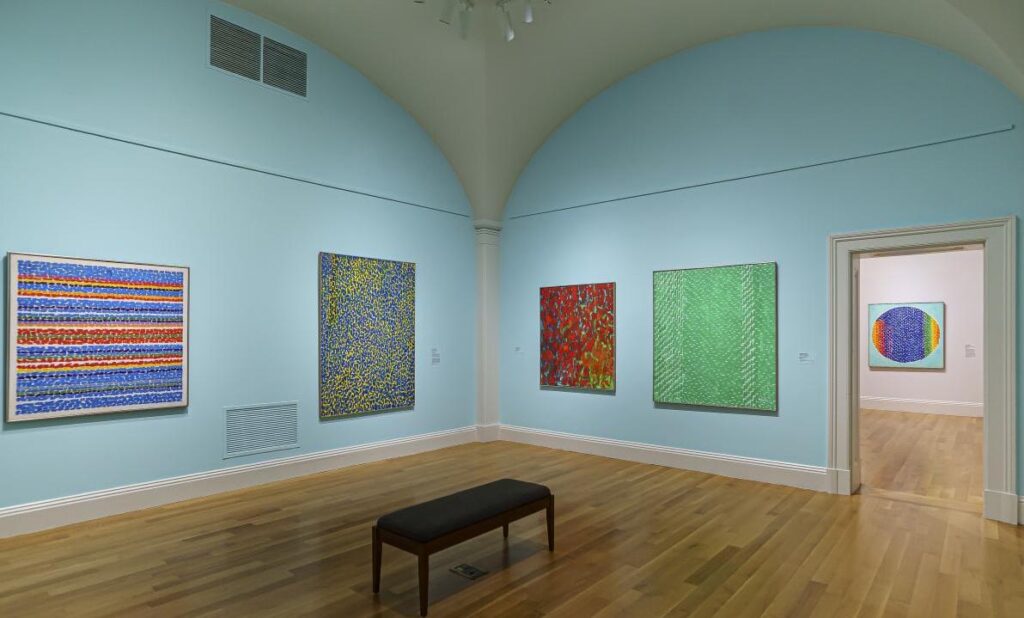
Composing Color: Paintings by Alma Thomas, currently on view at the Smithsonian American Art Museum, may well be the show Carrier called for. Or—if we are really lucky—perhaps it is a preview of an even larger realization of that vision.
The Composition of Composing Color
The Smithsonian American Art Museum (SAAM) owns the largest body of Alma Thomas artwork in any public collection—29 works, including 26 paintings and three works on paper. In Composing Color, SAAM exhibits 17 works from its extensive holdings, dating from the artist’s most prolific period, 1959 to 1978.
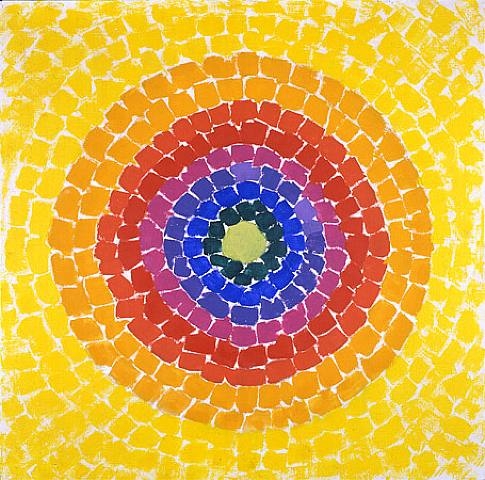
Resurrection, the first painting viewers see as they enter the show, is held in the White House Collection. According to The White House Historical Association, it is the first work by a Black woman to enter the Collection. After its unveiling in February 2015, it decorated the Family Dining Room during the Obama administration.
Resurrection is one of only two works in the exhibition not owned by SAAM. The other is Blast Off, a loan from Smithsonian’s National Air and Space Museum, which also holds three other paintings and some drawings by the artist.
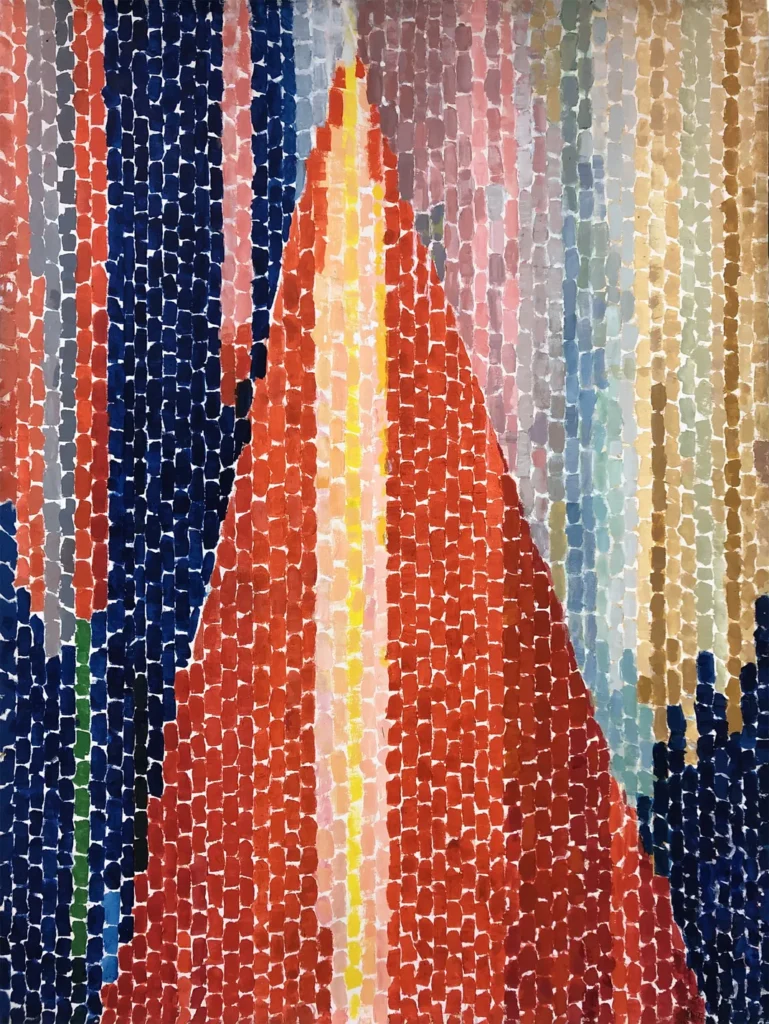
These are large-scale paintings; many of them measure four to five feet along their longer dimensions. The organizers have allocated generous wall space to each work, which helps the visitor to appreciate its full impact. It is beneficial too that the galleries have high ceilings, adding to the impression of roominess cushioning the art.
Three Galleries, Three Themes
The three rooms of Composing Color are organized around three of the artist’s favored themes, which inevitably overlap to an extent. (It would be difficult to draw a hard line between “seasons” in the second room and “nature” in the third.)
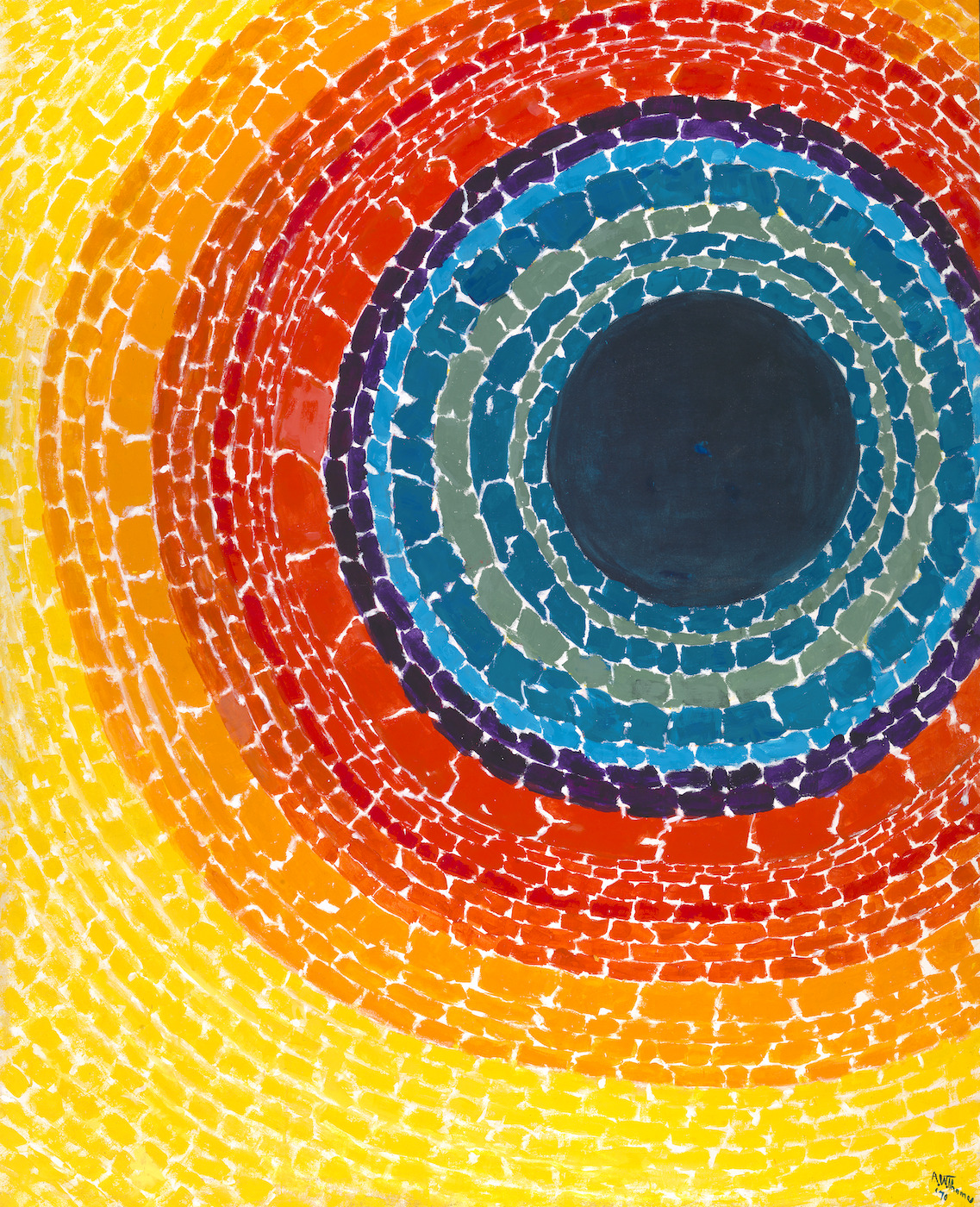
Space and the Cosmos
In the first gallery the visitor is treated to Thomas’ iconic The Eclipse, and Snoopy—Early Sun Display on Earth, among other space-themed paintings. “Snoopy,” according to the museum’s website, “was the nickname for the Apollo 8 lunar module… and the module’s job of flying around the moon to ‘snoop’ for a promising landing site.”
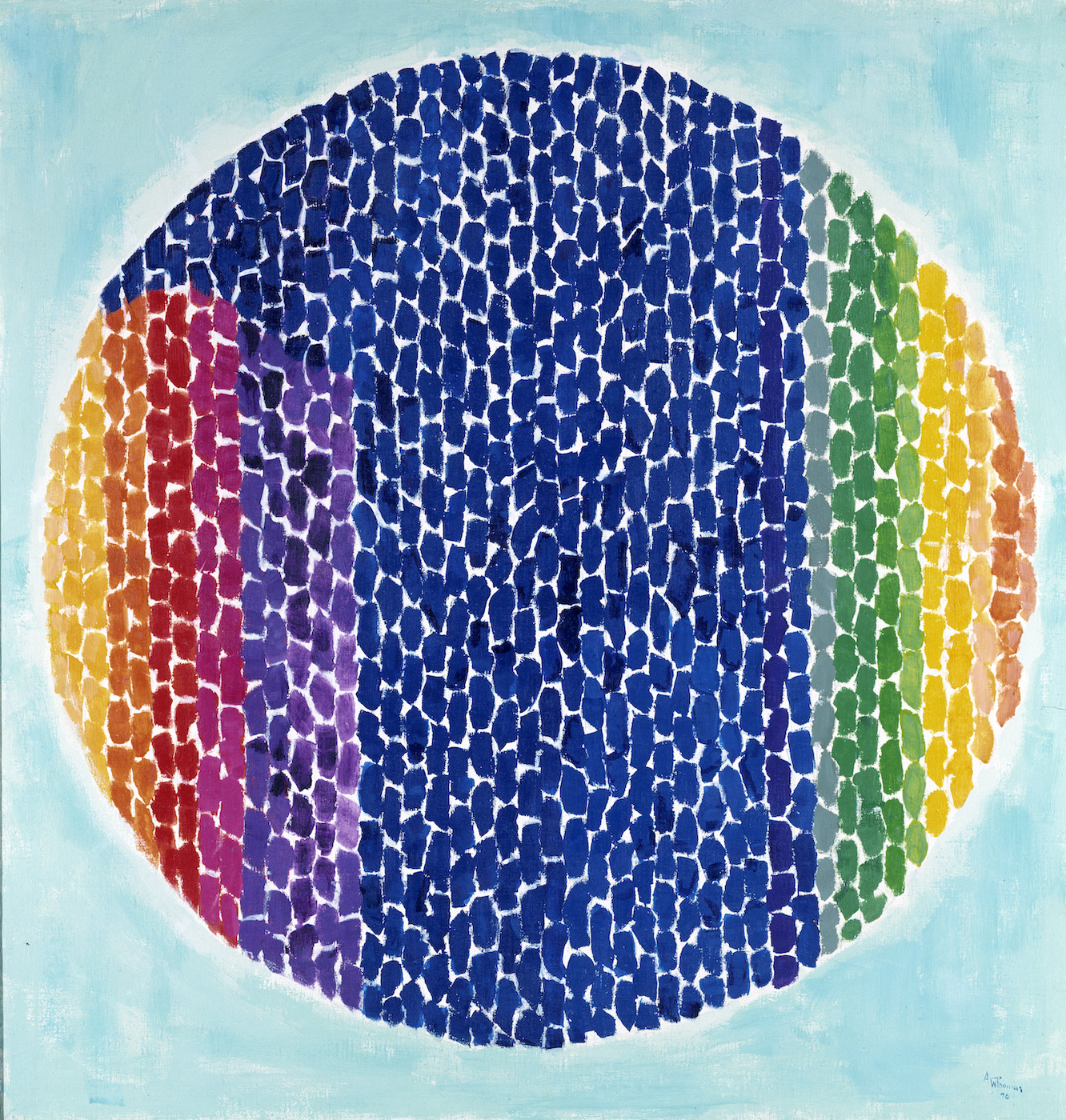
Earth and Seasons
All of the works in the second gallery are compelling. But Light Blue Nursery is of particular interest: it was the first Alma Thomas painting to enter the museum’s collection (in 1970). A favorite of then-Director Joshua Taylor, when not on loan to the White House, it adorned his office. In subsequent years, during the artist’s lifetime, SAAM acquired more than a dozen works. And Thomas donated a further 13 canvases to the institution by bequest.
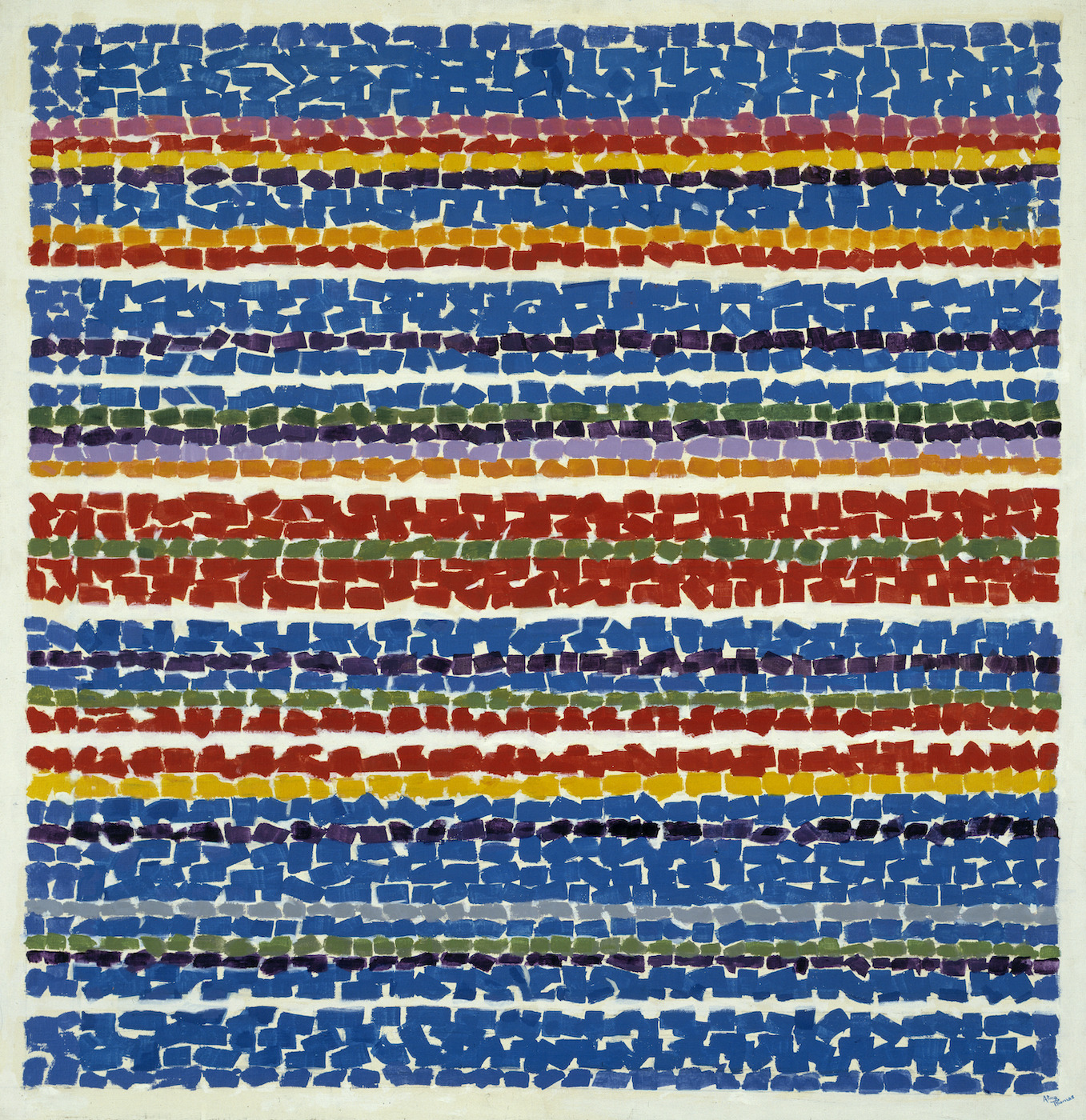
Nature and Music
Among the paintings in the third gallery whose titles directly reference both flowers and music are White Roses Sing and Sing, and Delightful Song by Red Dahlia.

Not present in this room, but referenced in the wall text, is a painting that visitors are advised they may view on the third floor. It isn’t exactly easy to find—one has to go around a couple of corners—but don’t miss Red Azaleas Singing and Dancing Rock and Roll Music. According to SAAM’s website, this triptych is “the largest painting of Alma Thomas’s career, created for what would be the last solo exhibition of her lifetime [Alma W. Thomas: Recent Paintings, 1975–1976 at the Martha Jackson Gallery]. Thomas painted it on three separate canvases, a format that enabled the artist to achieve ambitious scale despite her declining health and the modest size of her kitchen studio.”

During our visit, it was exciting to stand before this crowning accomplishment of Alma Thomas’ impressive career. (Admittedly we would not have found it without the assistance of a helpful museum staffer.) It would also have been satisfying to view Portrait of a Lady, Laura Wheeler Waring’s 1947 painting of the artist. But while SAAM does own this painting, it is not currently on display anywhere in the building. (There are a several works by Laura Wheeler Waring currently on view in The Harlem Renaissance and Transatlantic Modernism at The Metropolitan Museum of Art.)
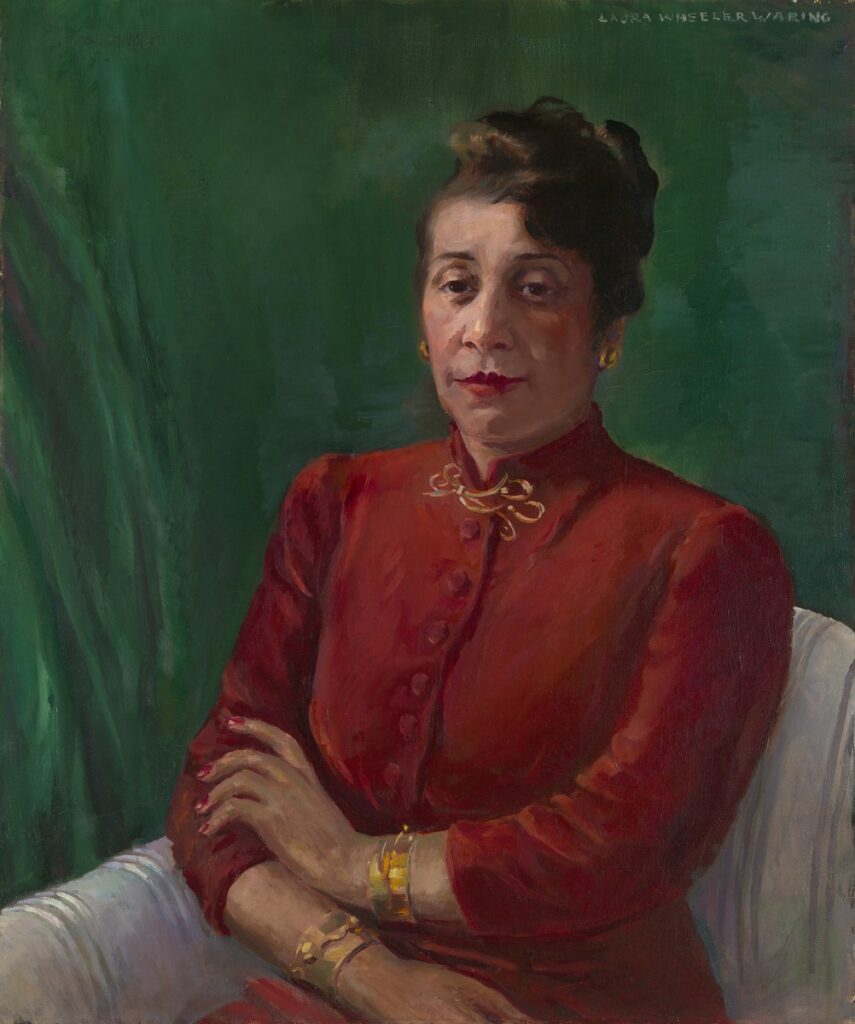
Ways to Experience the Art of Alma Thomas
Anyone who isn’t able to see the show in Washington, DC will have at least one other option. Earlier this month the Denver Art Museum announced it will welcome Composing Color: Paintings by Alma Thomas from the Smithsonian American Art from September 8, 2024 to January 12, 2025. [Update, February 14, 2025: the show is on at Memorial Art Gallery, University of Rochester from February 8–May 25, 2025. It will run at Indianapolis Museum of Art at Newfield, June 27–September 28, 2025.]
Whether or not Alma Thomas fans have the opportunity to view Composing Color in person, it is still possible to:
- Visit Let This World Be Beautiful: Celebrating the Life and Art of Alma Thomas, a two-part exhibition that the DC Public Library will present this spring;
- Attend the upcoming (March 9) panel discussion Alma W. Thomas: Curatorial Perspectives, with SAAM curator Melissa Ho, Samir Meghelli from the Smithsonian Institution’s Anacostia Community Museum, and Jonathan Frederick Walz from The Columbus Museum (also curator of Let This World Be Beautiful);
- Listen to this online audio guide, in which Melissa Ho speaks about selected paintings in Composing Color;
- In this post, view installation photos of the Composing Color galleries, and discover how the artist connects art, science, music, and nature; and/or
- Enjoy other online reviews of the show, including Shantay Robinson’s article for Smithsonian Magazine and Jack Kalm’s video walk-through of the show.
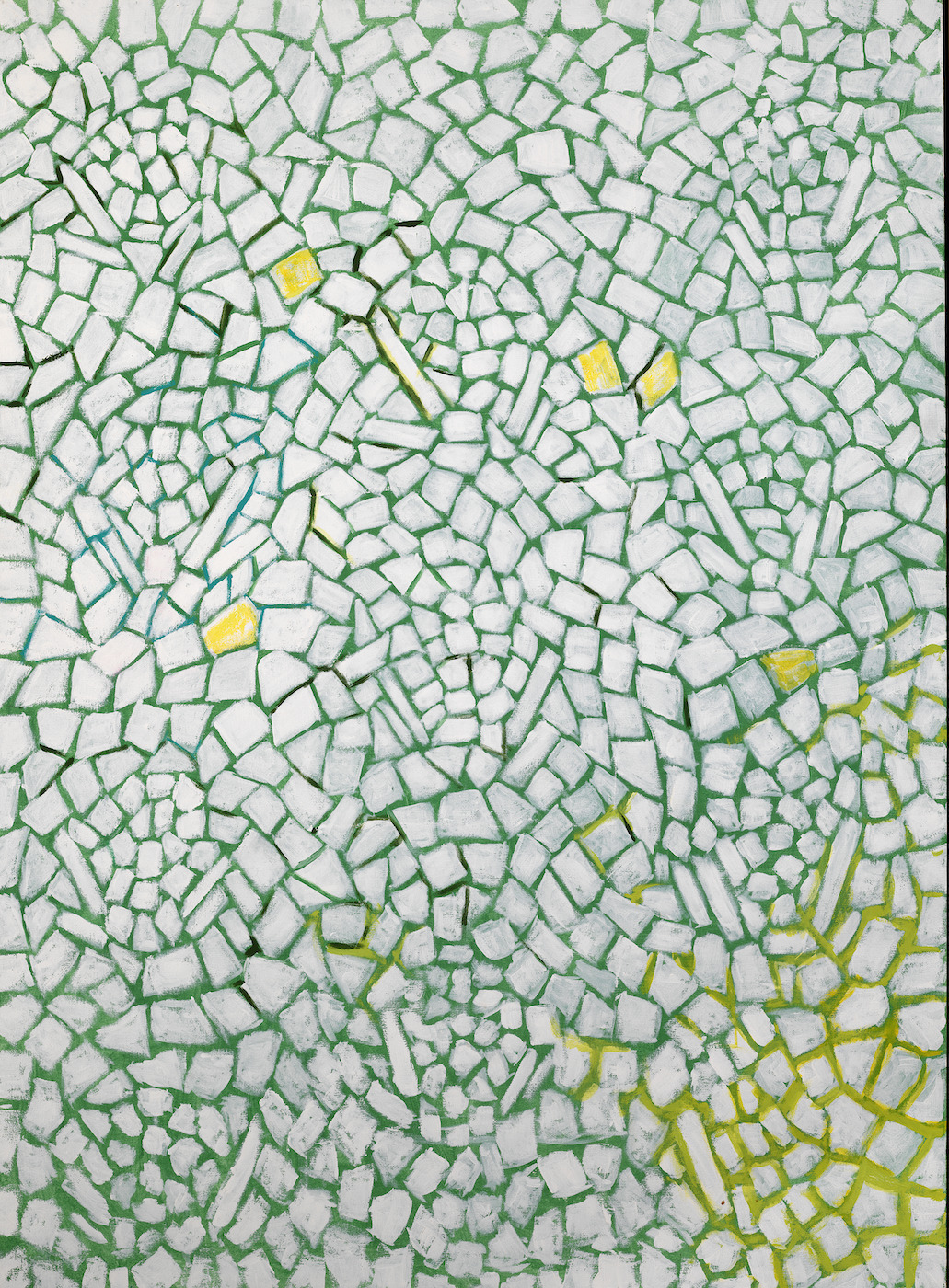
An Enduring Legacy
Although Alma Thomas died in 1978, her spirit lives on. Her joyous, colorful art is her lasting, and significant, legacy. Thomas’ enduring influence is evident today in—at least—the art market, new publications, and events that celebrate her life and work. And we see it in exhibitions of her paintings, of which Composing Color and Let this World Be Beautiful are only the most recent.
Alma Thomas and Washington DC
The Alma Thomas House, Thomas’ home for most of her life, is listed in the National Register of Historic Places. DC Mayor Muriel Bowser declared September 22, 2021 to be “Alma Thomas Day.” Bowser’s official proclamation—issued on the 130th anniversary of the painter’s birth—acknowledges Thomas’ artistic and educational contributions.
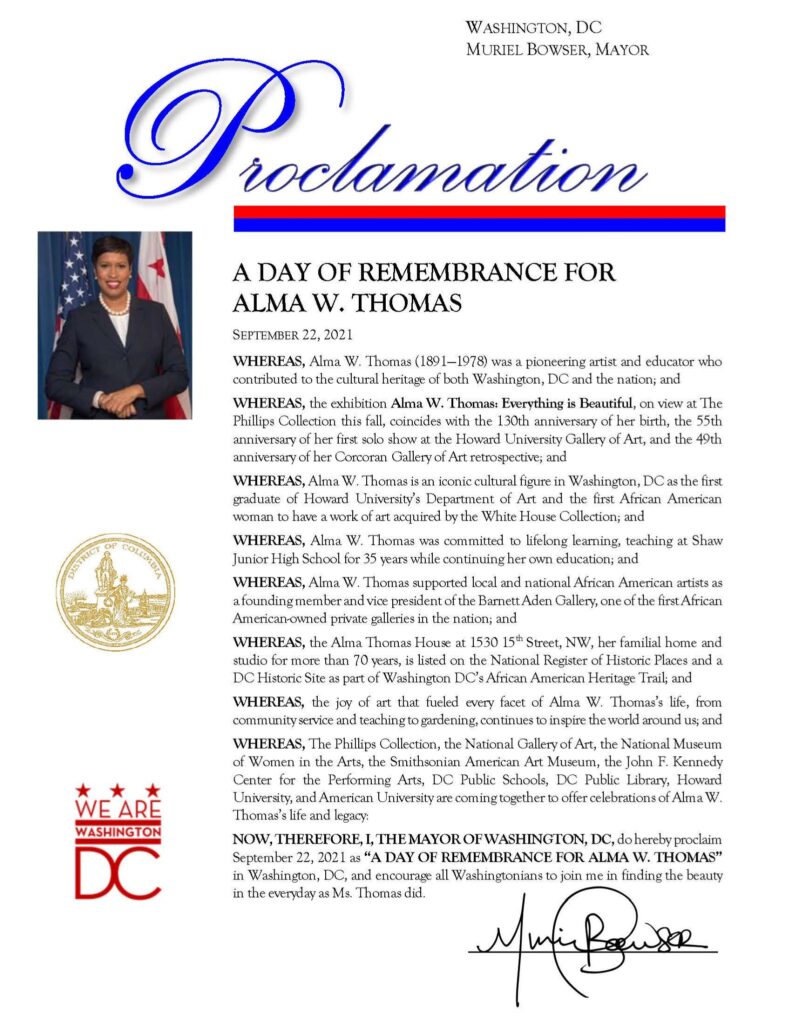
Art museums all over the United States own Thomas works, but—understandably—there’s a concentration in the DC area.
- The Hirshhorn Museum and Sculpture Garden owns eight works by the artist, including Earth Sermon–Beauty, Love and Peace.
- The National Museum of Women in the Arts holds two Thomas paintings, both of which are on display: Orion and Iris, Tulips, Jonquils, and Crocuses.
- The National Gallery of Art owns three works by the artist, of which one is currently on view (Pansies in Washington, in Gallery 407C).
- The Phillips Collection holds Breeze Rustling Through Fall Flowers.
- Given Thomas’ abiding interest in the cosmos and space exploration, it is not surprising that the Smithsonian National Air and Space Museum owns four paintings by the artist, and three watercolor sketches, which are not currently on view in their home museum.
- Not in DC, but not too far away, the Baltimore Museum of Art holds the painting Evening Glow, which is on display in Gallery 03.

Alma Thomas at Auction
The artist’s auction record speaks volumes about her legacy. These recent transactions are among the most dramatic on that front:
- In a March 2023 auction, Sotheby’s sold Snow Reflections for US $3,327,000 million, more than double the high estimate of US $1.2 million;
- A mere two months later, the sale by Christie’s of A Fantastic Sunset broke the Sotheby’s record, with a price of $3,922,000 (which price also exceeded the high-end estimate, though not quite as dramatically as in the Sotheby’s case since the upper end of the Christie’s estimate was US $3 million); and
- In 2021, South Carolina’s Greenville County Museum of Art deaccessioned Alma’s Flower Garden, selling the artwork to an anonymous buyer for US $2.8 million.
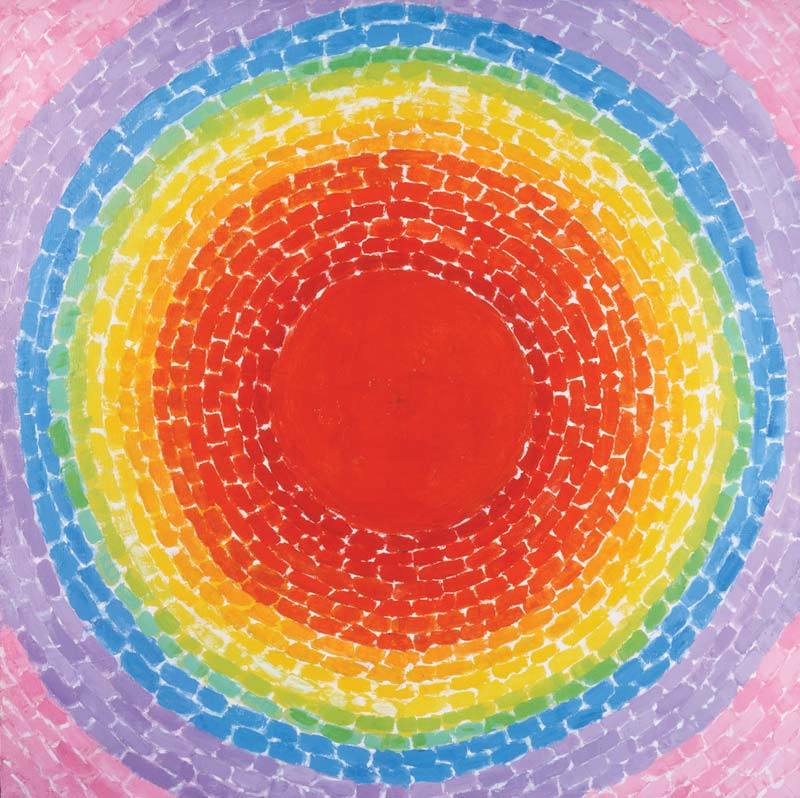
Recent Publications About Alma Thomas
Another indicator of the continuing resonance in our culture of Alma Thomas’ life and art is the number—and variety—of publications about the artist. These include:
- At least two books for young readers: Alma’s Art, by Roda Ahmed, illustrated by Anita Cheung; and Ablaze with Color: A Story of Painter Alma Thomas, by Jeanne Walker Harvey, illustrated by Loveis Wise;
- Alma Woodsey Thomas: Painter and Educator, by Charlotte Etinde-Crompton, for readers of middle school and high school age;
- The online graphic publication Beneath the Holly Tree: The Story of Alma Thomas, illustrated by Lauren Lamb (in “Drawn to Art: Tales of Inspiring Women Artists,” a series of short takes drawn by student-illustrators from the Ringling College of Art and Design, which focuses on women artists represented in the SAAM collection); and
- Alma W. Thomas: Everything Is Beautiful, edited by Jonathan Frederick Walz and Seth Feman, the catalog of the recent traveling exhibition.

A Major Anniversary; Another Major Exhibition in the Offing?
The 50th anniversary of the painter’s death occurs in 2028, just four years from now. Is it too much to hope for a monster Alma Thomas exhibition to mark that significant milestone? It wouldn’t be a first—most recently, of course, there was Everything is Beautiful, hosted by the Chrysler Museum of Art, The Phillips Collection, the Frist Art Museum, and the Columbus Museum. In 2016, The Frances Young Tang Teaching Museum and Art Gallery at Skidmore College and the Studio Museum in Harlem collaborated to present the retrospective Alma Thomas. For a comprehensive list of Alma Thomas solo exhibitions, see this page on the Michael Rosenfeld Gallery website.
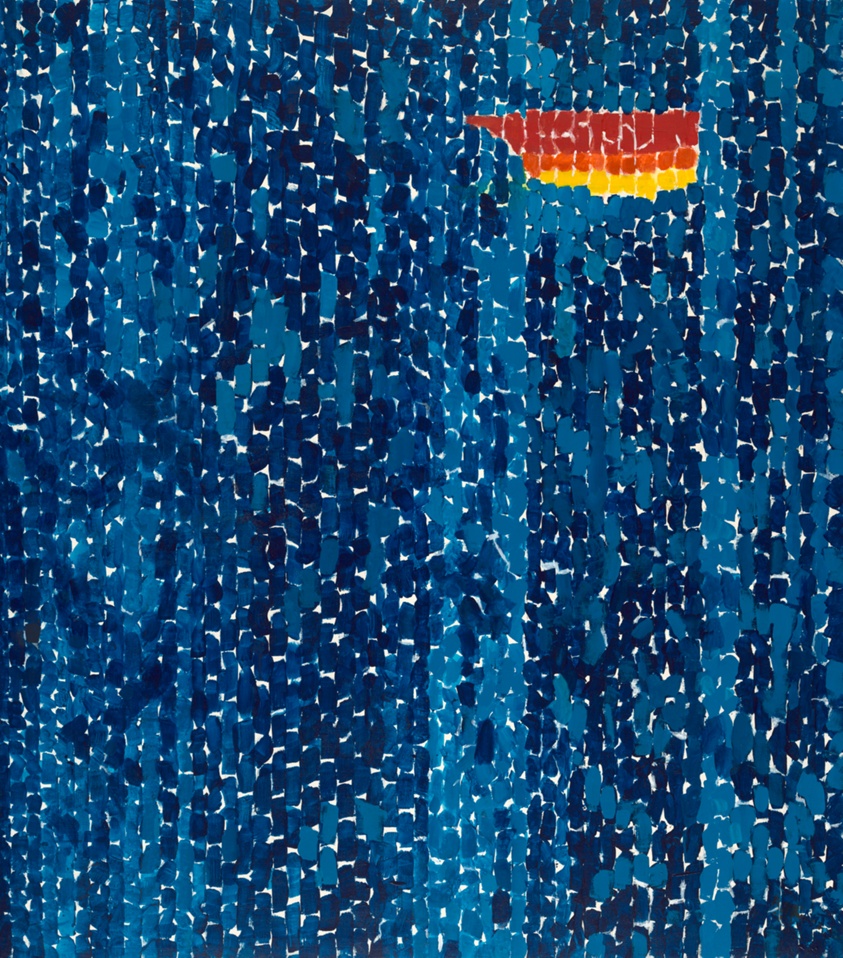
But of course the US is a big country; there are many more regions where audiences would welcome the opportunity to immerse themselves in the joyous art of Alma Thomas. Chicago, where the Art Institute is the home of her Starry Night and the Astronauts? New York City, where Alma Thomas was the first Black woman to have a solo exhibition at The Whitney, and where MoMA, The Met, and the Michael Rosenfeld Gallery also hold Thomas paintings? Boston, Connecticut? Los Angeles, San Francisco? And of course there are other possibilities …
Conclusion
Composing Color is indisputably a successful exhibition. Well-conceived and invitingly laid out, it delivers an uplifting visual experience and a fitting tribute to an important—and well-loved—American artist. Will a museum or group of museums honor the 50th anniversary (in 2028) of her passing by presenting an even larger-scale realization of Carrier’s vision of “a well-organized display of [Alma Thomas’] best work”? Let’s hope so!
Composing Color: Paintings by Alma Thomas is on view at the Smithsonian American Art Museum until June 2, 2024. It will travel to the Denver Art Museum as Composing Color: Paintings by Alma Thomas from the Smithsonian American Art Museum, where it will run from September 8, 2024 to January 12, 2025. Then the show is on at Memorial Art Gallery, University of Rochester from February 8–May 25, 2025. It will run at Indianapolis Museum of Art at Newfields, June 27–September 28, 2025.
Other Art Herstory blog posts you might enjoy:
A Quiet Eye—The Unique Achievement of Sylvia Shaw Judson, by Rowena Loverance
Reflections on the Audacious Art Activist and Trailblazer Augusta Savage, by Sandy Rattley
The Cheerful Abstractions of Alma Thomas, by Alexandra Kiely
Visual Feasts: The Art of Sarah Mapps Douglass, by Erika Piola
Women Reframe American Landscape at the Thomas Cole National Historic Site, by Erika Gaffney
Laura Seymour Hasbrouck, A Painter of the Hudson River School, by Lili Ott
Illuminating Sarah Cole, by Kristen Marchetti
Susie M. Barstow: Redefining the Hudson River School, by Nancy Siegel
The Ongoing Revival of Matilda Browne, American Impressionist, by Alexandra Kiely
Portraying May Alcott Nieriker, by Julia Dabbs
Celebrating Eliza Pratt Greatorex, an Irish-American Artist, by Katherine Manthorne
Happy Birthday, Fidelia Bridges! by Katherine Manthorne




I like the Red Azales Singing and Dancing Rock and Roll music art work